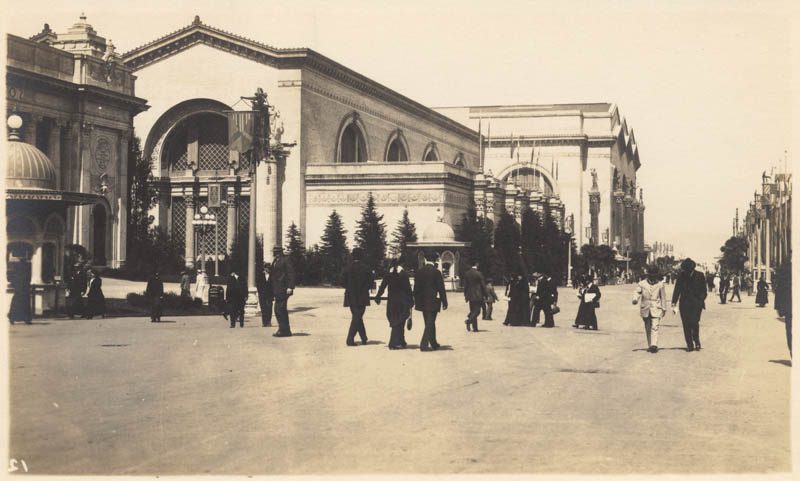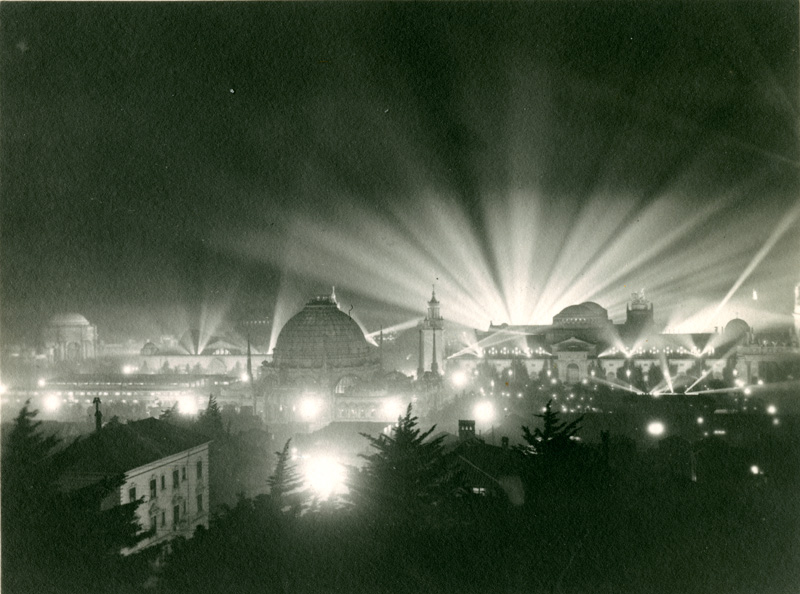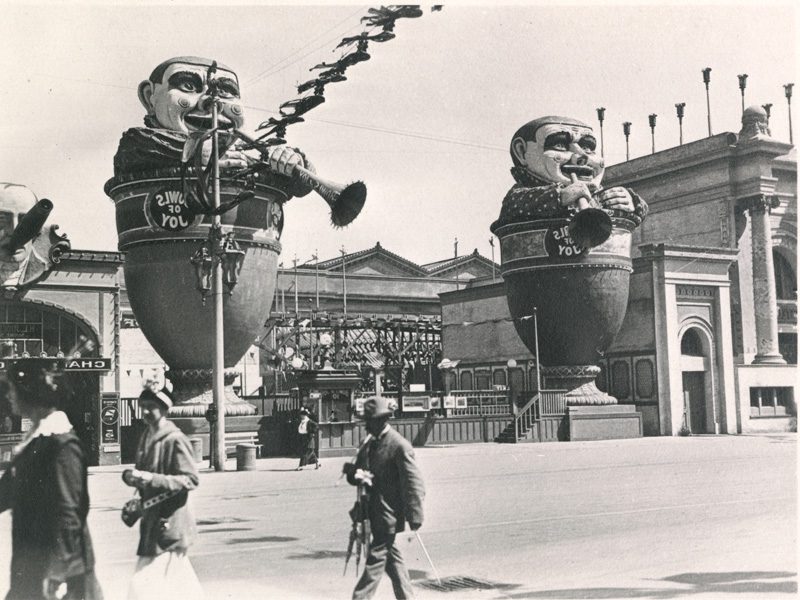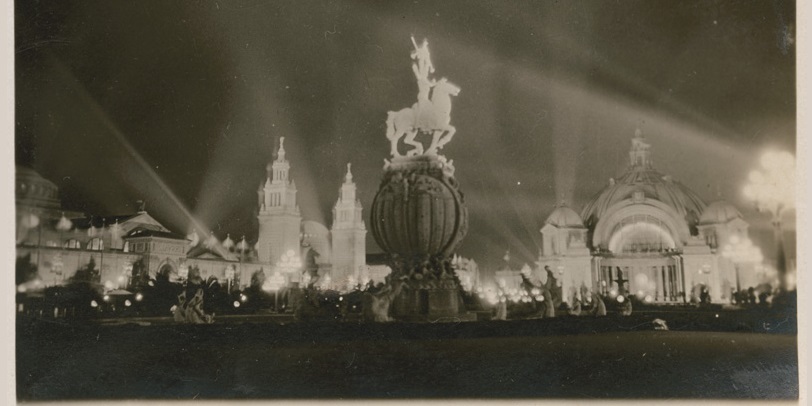It’s February 19, 1915. Top-hatted Mayor James “Sunny Jim” Rolph is at the head of 150,000 San Franciscans as they march from the Civic Center to Pacific Heights and down Scott Street to the entrance of the Panama Pacific International Exposition of 1915, a world’s fair ostensibly celebrating completion of the Panama Canal but designed to showcase San Francisco’s rebirth from the devastation of the 1906 earthquake.
Rolph, whose first three years as mayor have been consumed by preparation for the exposition, grows so excited he begins to run toward the entrance at Lombard Street. Those in the crowd who have already purchased a 50-cent opening day badge quickly follow.
Despite intermittent showers and occasional hail, the crowd clusters near the Tower of Jewels, the 435-foot tall centerpiece of the exposition, which covers 635 acres of reclaimed marshland — now the Marina District — bounded by the Presidio and Van Ness to the east and west, Chestnut and Lombard Streets to the south and the bay to the north.

The cost of improvements to the streets and the construction of the exposition site is usually cited as $15 million but Ralph Emmett Avery in his book on the building of the Panama Canal and the exposition puts the price tag much higher:
“The counties of California spent $3 million; the other states $8 million and foreign governments $5 million while $10 million has been spent in concessions and the exhibitors have spent something like $7 million so that it is estimated that the total cost of the Panama-Pacific international exposition is $50 million exclusive of the value of the exhibits, which is said to be at least $250 million although many of them are priceless.”
The day of the “Big Noise” is how the San Francisco Municipal Reporter, Fiscal Year 1914 to 1915, describes Saturday, February 20:
“Bells were rung, whistles blew and sirens sounded commencing at 6:30 am and continued for one hour. There was a great parade and fitting ceremonies at the exposition grounds. The municipal railways carried 287,424 passengers during the day and its receipts were $13,421.20.”
At noon, a telephone call is placed to President Woodrow Wilson in Washington D.C. telling him the exposition is ready to open. Wilson presses a telegraph key, which sends a signal to the antenna atop the Tower of Jewels whose name comes from the strings of 102,000 pieces of cut glass adorning it that sparkle during the day and are illuminated by 50 electric searchlights at night.

The signal goes to the diesel powerhouse behind the enormous Palace of Machinery where the chief engineer flips a switch, throwing open the doors of the exhibit halls, sending flags up their poles and propelling jets of water skyward from fountains throughout the grounds.
Warships anchored in the bay fire a deafening salute. A biplane piloted by Lincoln Beachey, a pioneering aviator, circles the spire of the Tower of Jewels. Beachey, a native San Franciscan, then releases four doves to cheers from the crowd below. He dies less than one month later at the exposition when a new monoplane he’s demonstrating crashes in the Bay.
In welcoming the first-day attendees, Exposition President C.C. Moore says:
“In our architecture, color, landscape, lighting effects, statuary, music and all branches of art and the material things of life as well, we have striven to produce a result that would benefit every visitor that comes within the exposition gates, mindful always that the event we celebrate warrants superlatively the best effort of all.”
The 10 main exhibit halls form a large rectangle surrounded by several courtyards with the Palace of Machinery at the eastern end. Its eight-acre interior makes the Palace of Machinery the world’s largest building and the first to have a plane fly through it. The Hearst Corporation has a printing press display to demonstrate how the Examiner is created.
On the west end of the exposition is the Palace of Fine Arts – the only structure from 1915 still standing. It showcases sculpture and works by Cezanne, Monet and Van Gogh. There are 1,500 sculptures and murals throughout the exposition as well as the 30,000 imported plants, trees, bushes and flowers, including 70,000 rhododendrons.

Anchored offshore is “The Scintillator,” a barge with 48 searchlights that project seven colors into the sky, simulating the “Northern Lights.” When San Francisco’s fog doesn’t accommodate, a locomotive generates steam for the lights to reflect from.
Twenty-one countries, all 48 states and 50 California counties have exhibits. Oregon, for example, builds a replica of the Parthenon but substitutes 42 redwood trunks for the Greek columns. A reproduction of George Washington’s Mt. Vernon is Virginia’s exhibit hall, which includes pieces of furniture used by the first president. Ohio recreates its state house in Columbus, sans dome.
Among the displays at the exposition is the first steam locomotive purchased by Southern Pacific Railroad; now housed at the California State Railroad Museum in Sacramento. The Liberty Bell travels by train from Pennsylvania to the exposition. It is the last time the Liberty Bell leaves Pennsylvania. A telephone line is established to New York so people can hear the Pacific Ocean.
Next to Fort Mason at the eastern end of the exposition is “The Joy Zone.” There are rides, games of skill and chance, live shows and the “Bowls of Joy” roller coaster. There’s a five-acre working replica of the Panama Canal, models of Yellowstone and the Grand Canyon plus “The Baby Incubators,” sumo wrestlers and “Creation” – “a splendid illusion showing the birth of the world and the beginning of life on this earth,” says the official exposition program, noting the special effects make it the Joy Zone’s most expensive attraction.

Europe is at war in 1915 and several of the combatants, notably Germany and Great Britain, cancel plans to attend. France, however, has a pavilion modeled after the Palais de la Légion d’Honneur in Paris. Alma Spreckels, wife of sugar magnate Adolph Spreckels, is inspired by the pavilion to build a permanent replica: The Palace of the Legion of Honor Museum in Lincoln Park opens in 1924.
The San Francisco Mint issues five commemorative coins, including two $50 gold coins — one round, the other octagonal. These are the first commemorative coins to bear the motto “In God We Trust.” When the exposition closes December 4, total visitors number 18,876,438. Revenue generated is $4.7 million. Constructed mainly of “staff,” a combination of plaster and burlap, almost all the fair’s buildings and attractions are pulled down by year’s end.
More information about the exposition can be found, among other places, at the National Park Service, KQED and Pan-Pacific International Exposition 100, a site commemorating the 100th anniversary of the exposition.
TOP PHOTO: Fountain of Energy, Festival Hall, Italian Towers, South Gardens. (State Library Image 2011-1964)

